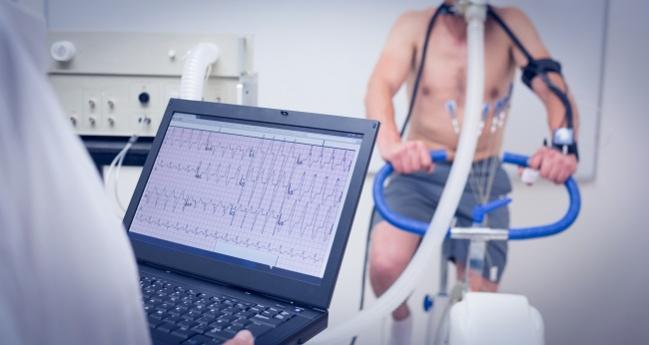Higher Fitness Again Tied to a Lower Risk of Death, Including CVD Mortality
Given the inverse association, researchers suggest physicians treat cardiorespiratory fitness as a diagnostic and prognostic vital sign.

For the second time in as many weeks, a study is hammering home the point that a life spent off the couch and being physically fit translates in greater longevity. In this latest analysis, investigators report that higher levels of cardiorespiratory fitness are inversely associated with the risk of mortality, including deaths from cardiovascular disease and cancer.
Given the link with mortality, investigators believe cardiorespiratory fitness is a clinical vital sign with important diagnostic and prognostic capabilities that should be tracked by all physicians.
“I’m a strong advocate for cardiorespiratory fitness, and I do think there’s value in actually having it measured,” senior investigator Leonard Kaminsky, PhD (Ball State University, Muncie, IN), told TCTMD. “All clinicians should be able to, at minimum, get an estimate of cardiorespiratory fitness from what’s available in electronic medical records—age, sex, body weight, and physical activity status, if it’s available—but you could get a lot more information, a lot more specific information, if you measured it.”
In 2016, the American Heart Association published a scientific statement on the importance of measuring cardiorespiratory fitness in clinical practice, noting that epidemiological and clinical evidence showed cardiorespiratory fitness was potentially a stronger predictor of death than traditional risk factors. “I think we’ve come a long way,” said Kaminsky, referring to the assessment of cardiorespiratory fitness. “The equipment is available, it’s much lower cost, and there are well-trained people all over the place now. So getting [cardiorespiratory fitness] into routine clinical practice is important.”
As reported by TCTMD last week, a large analysis from the Cleveland Clinic suggested there is no fitness ceiling when it comes to reducing the risk of mortality. That study, which included 122,000 patients referred for exercise treadmill testing, showed that those with low fitness levels had a significantly higher risk of all-cause mortality in long-term follow-up compared with those with high and above-average fitness levels.
The new study by Kaminsky and colleagues, which was published online October 29, 2018, ahead of print in the Journal of the American College of Cardiology, includes 4,137 healthy men and women who underwent cardiorespiratory exercise testing to determine baseline fitness levels as part of the Ball State Adult Fitness Longitudinal Lifestyle Study. The were 72 deaths per 10,000 person-years of follow-up, with mortality declining across fitness levels (80 vs 50 deaths per 10,000 person-years in the low- vs high-fitness groups, respectively).
In men and women, peak VO2 was inversely associated with the risk of all-cause, cardiovascular, and cancer mortality after adjusting for age, sex, examination year, and other clinical variables. In men alone, peak VO2 was inversely associated with all-cause and cardiovascular mortality, but the association with cancer was not statistically significant. Comparatively, peak VO2 was inversely associated with all-cause and cancer mortality in women, but the relationship between fitness and cardiovascular mortality was not significant.
These differences between men and women, however, are likely the result of “loss of statistical power” as the researchers drilled down into the data, said Kaminsky. “Be careful in interpreting those results,” he stressed. “This is more on the preliminary end of looking at [differences between men and women].”
Overall, individuals with low cardiorespiratory fitness (≤ 33 percentile of peak VO2) had a 73% increased risk of all-cause mortality and a more than twofold increased risk of cardiovascular and cancer mortality when compared with those with high fitness levels (≥ 67th percentile of peak VO2). Each 1-MET increase in cardiorespiratory fitness was associated with an 11.6%, 16.1%, and 14.0% reduction in the risk of all-cause, cardiovascular, and cancer mortality, respectively.
To TCTMD, Kaminsky said that cardiorespiratory fitness is “a whole-body measure,” and their study shows that it is a major contributing factor to an individual’s overall health. “I think the findings are quite robust,” he said. “The confusing thing sometimes for the population is the [use] of these terms—exercise, physical activity, fitness—as they all get jumbled together. They think they’re the same thing, but fitness is the outcome measure of the behavior of physical activity and exercise. Clinicians advocate to be active and get more exercise, but that’s a behavior, and people can do similar things but might not get the same response. That’s where individual biology plays out a little bit.”
In such circumstances, exercise specialists should tweak exercise programs—adjusting either frequency, intensity, or duration—in order to improve fitness levels. To achieve the fitness levels necessary to live a little longer, Kaminsky added that individuals need to “get into levels bordering the exercise realm” rather than simple leisurely activities, although the exact threshold and/or duration isn’t fully known yet.
Michael O’Riordan is the Managing Editor for TCTMD. He completed his undergraduate degrees at Queen’s University in Kingston, ON, and…
Read Full BioSources
Imboden MT, Harber MP, Whaley MH, et al. Cardiorespiratory fitness and mortality in healthy men and women. J Am Coll Cardiol. 2018;72:2283-2292.
Disclosures
- Kaminsky reports serving as a scientific advisor to ENDO Medical.


Comments